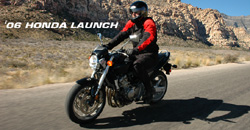|
|
|||||||||
HONDA VEGAS LAUNCH 2006
 |
|
Come ride with us? |
It’s an annual tradition with Honda Canada – book a track down south, ship a load of bikes and journalists in and let it rip for a few days. Apart from allowing a whole load of pasty-white journos out into the sun for a mid-winter ride, it also allows Honda to get said journos on their current crop of machines, with full reports published just in time for the new buying season.
Last year’s launch was to the Florida Keys, which although warm, was somewhat flat and over-policed. Thankfully this year saw the return to Las Vegas, with its luscious track, excellent Freddie Spencer School and decent selection of twisty roads.
Bike’s for launching included the heavily modified CBR1000RR, lightly modified 599 and Goldwing, and the screen & bagged VTX1300 Tourer. Oh, and the all-new (to Canada anyway) Reflex 250 scooter.
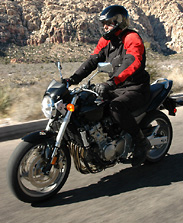 |
|
599 is a blast. |
In this article we won’t be covering the VTX since not much has changed (other than to note that we think a screen is a must on all cruisers). Neither will we be touching on the Goldwing – not because it isn’t worthy, no, it’s just that we already have a test of the BMW LT in the bag, in comparison to the Goldwing and so thought that a sidebar on the updates would be better suited there (that article's due to appear sometime in February BTW).
That leaves us with the Reflex (our main focus), the 599 and CBR1000RR.
Now for some reason, journalists were split into two groups (A and B), with the A group getting two days at the track and one day on the road, whereas the B group got two days on the road (of which one was used for photography) and none on the track.
Since CMG was delegated to group B – and so lacked the track time on the CBR1000RR – we’ve opted to look at more of the technical changes of the CBR rather than trying to ascertain any riding impressions.
Okay, everyone happy with that? Good, let’s get to it then …
THE NEW STUFF
REFLEX 250
 |
|
The Bronzewing? Photo: Honda |
This being the brand new bike of the bunch, it held the most interest to me. Interestingly, the Reflex has been available in the U.S since 2001, but for various reasons was delayed and delayed, until just when we’d all given up thinking about it, bam, it arrives in Canada. And just in time too, as the scooter market north of the border is on fire, with sales in 2005 up 131% over 2004.
The Reflex looks quite similar to the bigger Silverwing (Bronzewing?) and carries over the excellent fit, finish and overall feeling of quality from its bigger brother.
The seat is quite plush, with a good lower back support and narrow front area for easy feet-to-the-ground action. As with all scoots, there’s a cavern underneath, which provides 33 litres capacity and can hold one full-face lid. A large (non-adjustable) screen up front provides excellent wind protection.
Ergonomically wise, I’m a tad too big for it. Not horribly so, as my knees would only touch the bars when turning (spread ‘em in the corners boy!), but I’d estimate that anyone under 6 foot would be well accommodated.
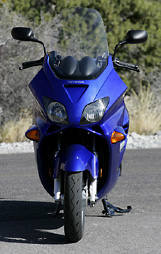 |
It’s powered by a single cylinder of 249 cc, the liquid-cooled motor being supplied by a carb (with auto-enrichener for lever-free cold starts). There’s some kind of in-built three-stage belt drive system (much like the 600 Silverwing) for different riding modes, which gives a good burst of acceleration up to the 40 Km/h mark and then … it goes oddly flat for a while. It does gradually pick up again up ‘til around 120 where it will eventually top out around the 130 mark.
I’m not sure why this is, as a CVT system should be able to keep it up at the most powerful rev range (which it doesn’t do post 40 km/h). All I can think of is that it’s a way to keep fuel consumption in the ultra-economical range (Honda suggested that the Reflex should be able to return around 60 mpg – that’s about 25 km/l or 4 litres/100 km).
Interestingly, this seems to be able to be modified by taking out 3 of the 6 rollers in the CVT system. I even found a page (3.0 Mb .PDF document) dedicated to the procedure, although we at CMG do not condone modifying a bike in any way …
I also found that by blipping the throttle with the brakes on, you can get the rear end to bounce up and down quite significantly. And it would have looked quite cool stopped at the lights on the Vegas Strip … had the bike not been adorned by a fat lanky Englishman sporting an inane grin.
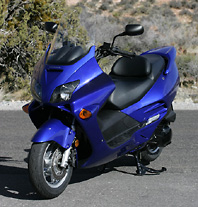 |
Brakes are excellent and come equipped with ABS (very flash for a 250 scoot). The left lever works the rear caliper and one piston of the front (three piston) caliper – one squeeze would bring you to a rapid, skid free stop – very effective. The right lever operated the other two pistons of the front brake. Of course, I somewhat missed being able to slide the rear to a lurid stop, but I assume this is just me and not the average Reflex owner.
Likewise, I found the suspension did a fine job, and combined with the Reflex’s low centre of gravity, nipping in and out of traffic was a breeze. I wouldn’t like to vouch for how it copes with potholes though, as suspension travel looks limited (like all smaller scoots).
Overall, in the two hours that I had it I had a blast, zipping in and out of the Vegas traffic and down deserted suburban boulevards. The motor’s a lot nippier than you’d expect from a 250 (save for the 40 km/h flat spot), the brakes are the best in the business and the suspension and handling are well matched to the machine. Unfortunately I didn’t have the time to try it out on the highway, but a top speed of 130 should make it doable, although maybe a little tight on longer runs.
MSRP has still to be determined, although it’s likely going to be close to the Big Ruckus, which retails for $6,999.00.
THE UPDATED STUFF
599
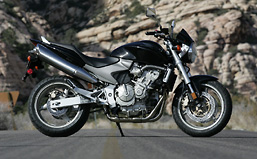 |
|
USD forks and revamped flyscreen/cockpit are new for '06. |
This year the 599 gets a bit of a makeover with USD forks (taken from the CBR600RR, but without the adjustability), a restyled cockpit (incorporating a flyscreen and new clocks) and a fuel cut-out in the carbs to prevent fuel being sucked into the engine on the over-run and thereby reducing emissions. The frame also gets a bit of a beefing-up to cope with the stiffer forks (stiffer forks = better handling, but more force transmitted to the frame).
The 599’s still a blast to ride. The motor likes to be thrashed to get the most from it, but it has a minimalist, hooligan air to it. Once you get used to the constant scream of the motor, the obedient chassis and quick handling make it a rather addictive ride.
The new cockpit should go some way to helping deflect the wind and the USD forks add to the overall more aggressive look and likely to the ride comfort as well (sorry, but we didn’t have an ‘05 to directly compare it to).
MSRP is $9,199.00, up $200 on the ’05.
Note – for a full test on the 2004 model, click here.
CBR1000RR
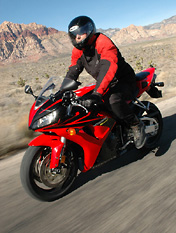 |
|
It's all been tweaked. |
Although on the surface it may appear that not much has changed to the CBR1000RR, almost everything has been tweaked in some manner, from the motor to the chassis to the more aggressive styling.
And let’s start there. It’s the Michael Jackson of makeovers, with a new nose, revamped arse and a less enclosing side fairing to expose more of the motor and, err, nether regions. Thankfully, all this results in a much more aggressive look and not an indecency charge (which of course would be proven to be untrue).
The motor gets a host of changes, with the top end getting straighter intake & exhaust ports, along with reshaped valve heads (for better flow), as well as higher lift cams and a bump in compression ratio (up from 11.9 to 12.2). The crank also gets beefed up, the ram air inlets widened and the redline increased to 12,200 rpm.
All these changes help the top end power delivery, with maximum torque 1,500 rpm higher up (now at 10,000 rpm) resulting in a 3.4% power increase (and an unofficial 160 bhp at the rear wheel). The rear sprocket’s also been increased by a tooth to ensure that the extra power results in increased acceleration, while top-end speed remains unchanged.
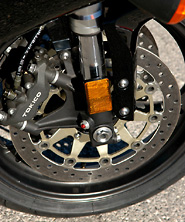 |
|
Bigger discs need shims added to space out the radially mounted calipers. |
There’s a new and lighter underseat exhaust that manages to be emissions compliant without the need for a catalytic converter, enabling aftermarket cans to be simply fitted without increasing the overall emissions level. The clutch and gears have also been redesigned to allow easier acceleration from a standing start, reduced backlash and to provide more positive gear engagement.
Chassis wise, the steering rake has been brought in by a quarter of a degree to sharpen it up, along with a 4mm shorter swingarm, which when combined give a 5.4 mm reduction in wheelbase. Suspension springing has also been softened.
Front brake rotors have been increased by 10mm in diameter and are also thinner to help keep overall weight down. In fact, thanks to weight saving in a host of parts, Honda claim that the overall dry weight is down by a noteworthy 6 Kg.
I did manage to get a few hours riding the CBR on the freeway and a gnarly piece of road in the Valley of Fire and it all seems to work. Whether or not the CBR can compete with the other litre sport bikes is a matter of riding them back to back, although I suspect that the Honda's strengths will be more on the road than the track, thanks to its more generous ergonomics.
MSRP is now $15,249.00 – up $250 from ’05.
![]()
